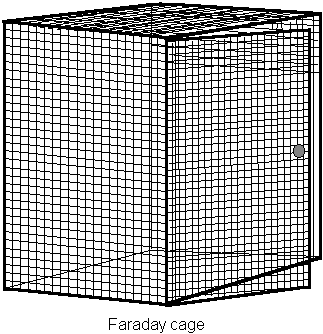Contents of a Faraday Cage are shielded from static electrical fields. The term is named after the individual that discovered the property of the structure, Michael Faraday. It is a metal cage that is an electromagnetic shield. An electrical charge on the exterior of a conductor cannot effect on anything inside the conductor. Also, if an electric charge is applied to the inside of the metal enclosure, it spreads all over the outside surface and will ultimately produce no electric field inside!
One real world example of the Faraday Cage is that of an aircraft. Passengers inside of an aircraft that is struck by lightning are unharmed by the lightning. The metal body of the aircraft protects the interior.
Individuals in amateur radio are interested in the properties of the Faraday Cage. Consider that a radio transmission made from within a metal automobile when the radiating antenna is also within the automobile has difficulty escaping to the exterior, greatly reducing range of transmission. If it were not for the windows and other non metal parts of the car, the radio transmission could not escape at all. This is why radio operators place antennas outside the interior of the automobile.
Individuals that work with electric utilities and AC also are interested in the design from an engineering perspective. The principles are applied to the design of modern electric generators. The design is also used to create protective enclosures for safety of persons and control equipment.
Your home Microwave oven appliance utilizes a Faraday cage to protect you while you are heating your food. When you look though the window of the Microwave you can see through holes in the metal construction. Microwave ovens use a frequency of 2.45 Ghz. That gives them a wavelength of about 12 cm and a mesh hole shielding requirement of 1.2 cm or smaller. The point is that the particular design of a Faraday cage will determine what wavelengths of RF are shielded and allowed to pass. Any given metal mesh structure does not serve to block all wavelengths of RF.
Crazy "cooks" known as "survivalists" and "preppers" are also interested in the protective properties of the Faraday Cage in a misguided belief that it will help them protect their electronics from an EMP pulse attack. They are just crazy, however, there is a growing industry profiting from the lunacy of people lacking the proper technical background and fiscal responsibility. The designs used by these preppers are by and large inadequate to provide the protection the owner anticipates.
Areas of study and experimentation using a Faraday Cage:
- Radio experimentation. Your transmissions can be contained as to not create harmful interference.
- Equipment protection. Equipment within the cage should be shielded from external electromagnetic radiation.
- Personal protection. Protect your body from strong electromagnetic fields by working from within the cage. For a radio operator, reduce RF exposure by placing the radio operator within the cage using remotely controlled transmitters.
- Laboratory use. The size and spacing of the metal and various designs can be studied in relation to RF frequency and strength.
The Faraday Cage is from the principles discussed in Faraday's Law. Electromagnetic induction was discovered by Michael Faraday in 1831. Just a year later Joseph Henry also made the same discovery without any knowledge of Faraday's work. Today we honor these two pioneers with the measurement unit known as the Farad and the Henry. The Farad (F) is the unit measurement of capacitance and the Henry (H) is the unit of measurement of inductance.
Faraday's law
Our understanding of electromagnetism and how it interacts or relates to induction in an electric circuit comes from the work of Michael Faraday. This law states, "The induced electromotive force in any closed circuit is equal to the negative of the time rate of change of the magnetic flux enclosed by the circuit."
This is not an absolute truth, and therefore modification to address real world electric circuits was necessary. The revision is introduced as the Maxwell–Faraday equation. This states, "A time-varying magnetic field is always accompanied by a spatially varying, non-conservative electric field." This law applies both ways. The Maxwell–Faraday equation is one of the four Maxwell's equations, and therefore plays a fundamental role in the theory of classical electromagnetism.
Magnetic Resonance Imaging (MRI)
In a hospital the MRI machine is contained within a giant Faraday cage. Shielded Faraday Cage installations are used to RF shield all types of permanent and superconducting magnet MRI scanners. These are typically constructed of aluminium, or in certain conditions galvanized steel. Without such protection the very weak RF signals that emanate from the patient when scanned would be overwhelmed.
The MRI machine is very sensitive. Any RF interference will prevent the machine from resulting in an image. By placing the MRI inside of a room that is constructed as a Faraday cage, external radio interference is blocked from entering and polluting imaging data from the patient. Radiographers are trained to identify the characteristic artifacts created on images should the Faraday cage be damaged.
